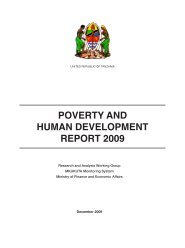Download PDF (4.08 MB) - ReliefWeb
Download PDF (4.08 MB) - ReliefWeb
Download PDF (4.08 MB) - ReliefWeb
Create successful ePaper yourself
Turn your PDF publications into a flip-book with our unique Google optimized e-Paper software.
128<br />
References and suggested further reading:<br />
Resource mobilization<br />
• Boyce, James K. Post-Conflict Recovery:<br />
Resource Mobilization and Reconstruction.<br />
Paper prepared for the UN Department on<br />
Economic and Social Affairs Expert Group<br />
Meeting on Post-Conflict Recovery and<br />
Economic Security. 2007.<br />
• IASC CAP Sub-Working Group. Guidelines for<br />
Flash Appeals. March 2009.<br />
• IASC Cluster Working Group on Early<br />
Recovery, CAP SWG. Including Early Recovery<br />
Requirements in Flash Appeals: A Phased<br />
Approach. January 2009.<br />
• IASC Cluster Working Group on Early<br />
Recovery. Guidance Note on Early Recovery.<br />
Prepared in cooperation with the UNDG/<br />
ECHA Working Group on Transition, April<br />
2008.<br />
• ILO/Crisis. “Financing LER,” Chapter in,<br />
Local Economic Recovery in Post-conflict.<br />
ILO and Cluster Working Group on Early<br />
Recovery. 2010, pp.170-173. http://<br />
www.ilo.org/wcmsp5/groups/public/@<br />
ed_emp/documents/instructionalmaterial/<br />
wcms_141270.pdf<br />
• UNDP Resource Mobilization Toolkit. http://<br />
resourcemobilization.brsp.undp.org/<br />
• UNDP. TRAC 3 Guidelines. http://content.<br />
undp.org/go/userguide/finance/rsrc-planbudget/resources-for-special-developmentsituations/?lang=en#top<br />
• UNDP. UNDP Thematic Trust Fund for Crisis<br />
Prevention and Recovery. http://www.undp.<br />
org/cpr/whats_new/framework.shtml<br />
• Central Emergency Response Fund (CERF). A standby fund linked to Flash Appeals<br />
and CAPs, the CERF is designed to enable predictable, timely, and equitable responses<br />
to humanitarian emergencies. Early recovery proposals have been packaged in the<br />
contexts of “time-crucial” and/or “protection” interventions within the CERF mechanism;<br />
in rare instances, this has led to limited financing of early recovery projects.<br />
• Common Humanitarian Fund (CHF). Managed by the Humanitarian Coordinator,<br />
CHFs provide early and predictable funding for response to critical humanitarian<br />
needs, as identified in a CAP. CHFs also maintain an emergency reserve for responding<br />
to unplanned emergency needs outside the CAP. CHFs have served to scale up<br />
resources in difficult operating environments. In situations where donors cannot work<br />
through government systems, for example, CHFs allow donors to “shadow align” with<br />
them. In all existing CHFs, UNDP is the financial fund manager and is also tasked with<br />
subcontracting NGOs on behalf of the CHF.<br />
• Multi-Donor Trust Funds (MDTF). MDTFs can be designed and established so as<br />
to finance specific interventions, including those for recovery. MDTFs typically allocate<br />
funding on the basis of needs included in national strategies. Furthermore, MDTFs<br />
often rely on government structures for administration and implementation and<br />
are therefore useful in terms of developing government capacity. A disadvantage of<br />
MDTFs is the time lag that typically occurs between the establishment of a fund and<br />
disbursement to implementing agencies (8-18 months).<br />
• The Peacebuilding Fund (PBF). The PBF is designed to address crucial funding gaps<br />
between conflict and recovery for post-conflict countries, through the disbursement of<br />
emergency grants for activities that support peace processes in post-conflict settings.<br />
The PBF provides funding only to countries that are before the Peacebuilding Commission<br />
or countries in similar circumstances as designated by the Secretary-General.<br />
The PBF is a good source for seed funding for livelihoods and economic recovery. In<br />
most cases, it has funded youth employment programmes, for example in countries<br />
such as Guinea Bissau, Liberia, and Sierra Leone.<br />
Box 7.2. Early recovery funding in Pakistan 72<br />
Resource mobilization for early recovery following the 2005 earthquake in Pakistan was highly successful, at 87 percent of the proposed budget for the Early<br />
Recovery Plan. Donors gave the following reasons for their substantial contributions: (1) donors were genuine partners in the assessment and planning<br />
processes, so early recovery remained on their minds even months after the disaster; (2) the U.N. team highlighted early recovery at the early stage and kept it<br />
on the agenda until donors were ready to address it; (3) a respected, high-level government official recognized the importance of early recovery and became<br />
a champion; and (4) coordination among U.N. agencies and with the government during the relief phase created donor confidence.<br />
The importance of making sure that donors are genuine partners in the entire relief and recovery process and ensuring effective coordination were therefore<br />
among the key lessons learned. Openness about past shortcomings can help to build trust. Donor participation in decision-making makes such donors unlikely<br />
to deny or forget the need for funding. When all partners—including the government, donors, and NGOs, as well as the U.N. agencies—work together<br />
as a team, donors are less inclined to leave the funding of early recovery to “someone else.”<br />
72 Based on a contribution from Andrew MacLeod,<br />
RC Office, to an internal UNDP e-discussion on<br />
early recovery.<br />
Livelihoods & Economic Recovery in Crisis Situations





